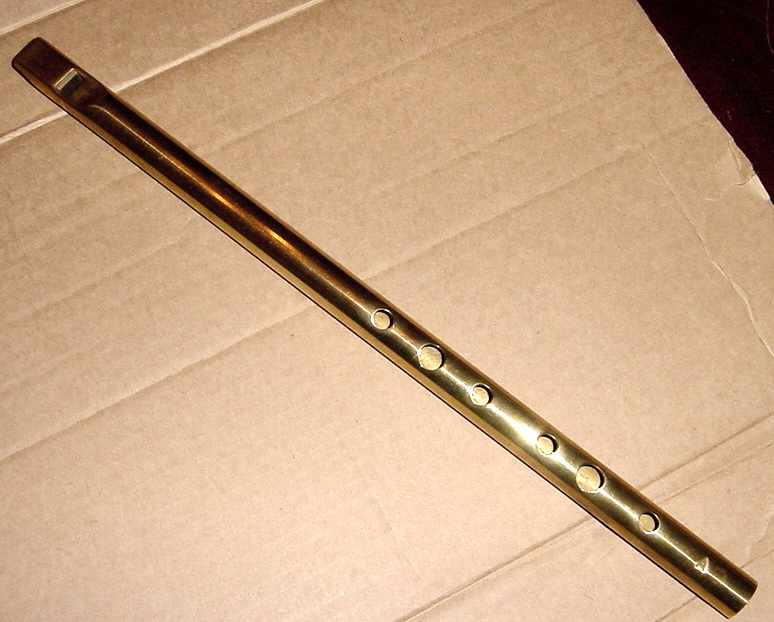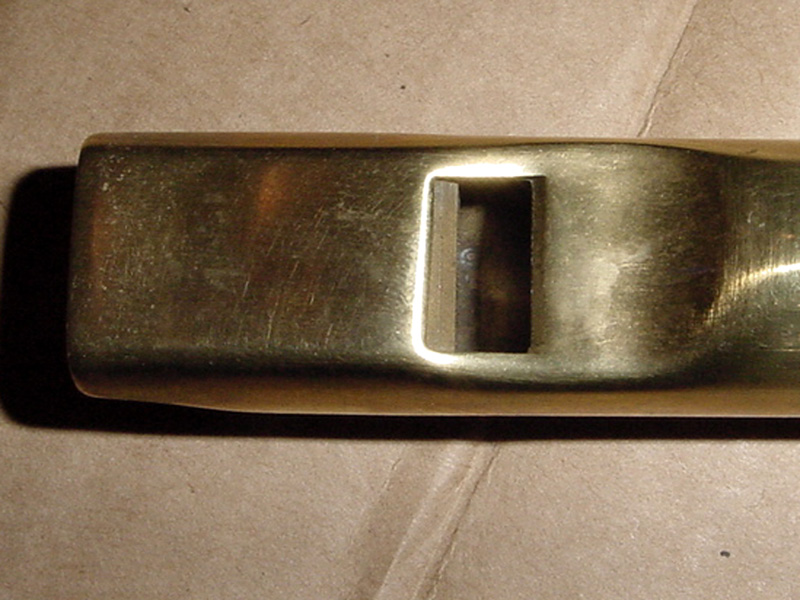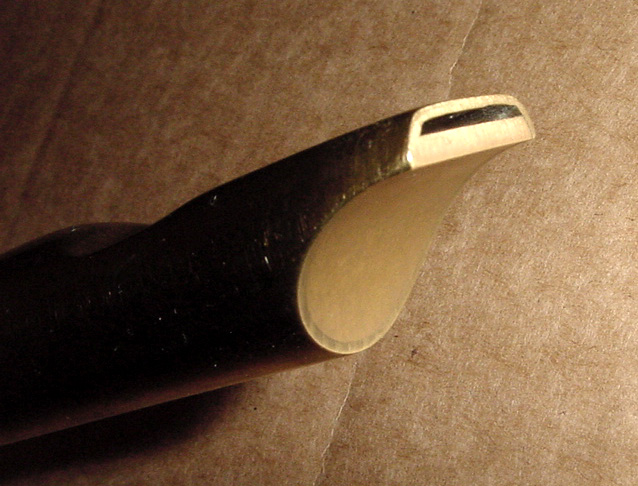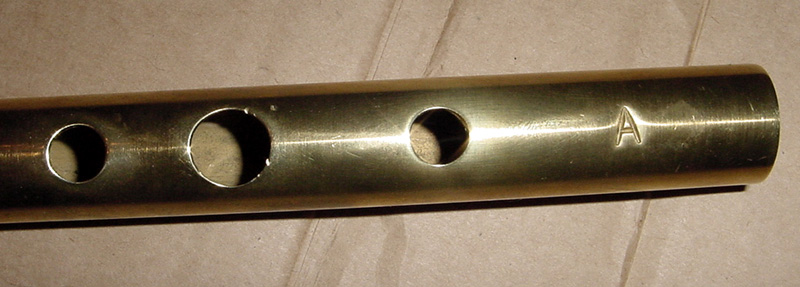Chieftain Mezzo-Soprano A whistle
(Review written July 2005)
Preface
I've played a few different Chieftains over the years. Shortly after taking up the tinwhistle in 1995, someone gave me a copy of Joanie Madden's A Whistle on the Wind, which was quite an inspiration. The liner notes noted that Joanie played whistle and this thing called the "low whistle. I was intrigued; even just the name sounded mysterious to my new-to-whistling ears. After searching the internet for any information on whistles at all (which was a chore in those days, let me tell you), I ended up getting a Chieftain low D from Lark in the Morning. I think I'd been playing all of six months.
Since that time, I've owned a Chieftain soprano D, a Chieftain Kerry Songbird low D, and a Chieftain new Range low D. And now, I have this Chieftain Gold Mezzo-Soprano A. I've played a few chieftain Gold whistles before, but never at length. As best as I can determine, the Gold models went into production in 2001, and had a limited run into 2002. I heard that they came back into production for a very limited run, but to the best of my knowledge, that was very short-term. They still come up on Ebay from time to time. It's been interesting watching their evolution over the years.
Since we're in a weird in-between key, I wanted to talk a bit about naming conventions of whistles. For years, I only ever thought of whistles as "regular" (or "high") and "low". For the key of D, this terminology works fine. But as you start getting into other keys between D and low D, the line gets a little fuzzy. Take this A for instance. Would you call it high or low? Some people would call it low. But nobody really makes a "high" A under this scenario. It would be smaller and shriller than a Generation G! And some makers do make an A whistle an octave below this one. Would you call that low-low A? So we have a low A, a low-low A, but no high A? Is that kind of like the fast food place at my house that has medium and large and extra large, but no "small"? Didn't medium used to mean in the middle, between some other choices?
Because of this confusion, many makers have taken to naming their instruments using the same musical lingo as is used in naming other instruments like the recorder or singing voices (alto, tenor, soprano, etc). This helps some, but not completely. For instance, this whistle's bell note (the lowest note playable) is A4, which has a pitch of 440Hz. Some whistle manufacturers call this an alto. Phil Hardy calls it a mezzo-soprano. It's the same thing, though. Confusing? Could be!
Alto is generally what a recorder would be called. Mezzo-soprano ("half soprano") is a term used for the female singing voice that covers part of the range of the Soprano, part of the range of the Alto. There's actually some overlap in these naming conventions, and tinwhistles end up not fitting neatly into them, either. It's a bit of a mess. I've ended up calling high whistles "soprano", low D whistles "low" (though they could be called tenor), and in-between keys generally whatever the manufacturer would call it, so that if you're looking to buy one, you and the manufacturer can speak the same language.
At a Glance
Whistle Reviewed: Chieftain Gold mezzo-soprano A
Models Available: Discontinued, but was made in all standard keys.
Construction: heavy brass
Price at time of review: Whatever you can get one for secondhand.
Available From: Ebay or other auction sites of your choice. You might get lucky and find a smaller music store that still has some in stock. But I wouldn't expect it.
How Acquired: received secondhand.
Appearance/Construction
The Chieftain Gold line is very typical of other whistles under the Chieftain name. It came out after the chieftain old style whistle, but before the New Range. It's got a nice even brass color with a brushed finish. It's a bit heavy, owing to the brass, but I haven't found that to be a problem personally. At the time that it came out, it was more neatly made than the chieftain old style whistle, and many of its features made their way into the Chieftain New Range.

Here's the full whistle.

Here's a close-up of the mouthpiece. Note that the fipple protrudes maybe a fraction into the mouthpiece. The New Range Chieftain whistles and Sweetheart whistles also have this characteristic. Ralph Sweet reportedly says doing this improves tuning between the octaves.

Here's another angle on the mouthpiece, showing the fipple area. The mouthpiece/fipple area here is a lot more like the old style Chieftains.

A shot at the end of the whistle, showing the last three holes. The key of the whistle (A) is stamped into the base. You can see a couple of dings around the second-to-last hole...they're relatively minor, and I don't expect that they've changed the tuning on this whistle.
Sound clips of the whistle:
Off to California (you can hear a penny in my clothes drier going "tink tink tink!" in the background)
Playing Characteristics
Tone: Bright and crisp. This is definitely a plus if you're going to use the whistle for anything besides airs. My old style chieftain really wasn't that good for faster tunes, but this one is well suited for them. It's pure and sweet sounding, with a nice start-of-note chiff. It's keeps that sweetness throughout the second octave; it's not at all offensive or brash even at the very top of it's range.
Volume: Average. The whistle is a little bit louder than my Sweetone whistle.
Responsiveness: Responsive--that's part of the "crisp" above. Again, my old style Chieftain wasn't nearly as responsive. This whistle is just so much easier to play than the old style Chieftains. It really represented a great leap forward in Phil's whistle design.
Tuning: Like the Old Style Chieftain I owned, this whistle required a fair amount of warm-up before it came into tune. If I set it down for 5 minutes, it'd be cold again. So again, like the Old Style whistle I owned, it takes a bit of constant attention (tucking under your arm, sitting on it, or something) to keep it warm if you're not playing it on every tune. But when warm, this whistle is nicely in tune.
G (An A whistle equivalent to C-natural): When warmed up, this whistle plays G with OXXOOO right on the money. OXOOOO is about 15 cents sharp.
Hole size and placement: 'A' whistles are an awkward size. They're really not quite low whistle size, and not quite high whistle size. When I play low whistles, I play fingertip-style instead of piper's grip, using my pinkie on the lowest hole. When I play the Susato VSB A, I play the same way. But with this whistle, I find it more comfortable to play it just like a high D tinwhistle, fingertip style with my ring finger on the lowest hole. Then again, I do have a pretty wide stretch to my hands. You may end up deciding that you low-whistle grip suits you better on this whistle. But definitely the holes are a little easier to reach than the Susato VSB A I had.
Air volume requirements: Average. The whistle takes about the same amount of breath as a Sweetone.
Air pressure requirements: Low. This is a really easy blowing whistle. It doesn't take much to play, and it was effortless to play the entire range of the second octave. This is also a huge improvement over the old style Chieftain.
Clogging: Like the Overton soprano D I recently reviewed, this whistle would clog fairly quickly when cold. It didn't cut the whistle out, but it did pretty much destroy the second octave, making it honk a lot more readily. When warm, it didn't clog at all. I'd likely give this one the Duponol treatment if I was going to be playing it much in public.
Wind Resistance: Low. Like the Chieftain NR low D I reviewed, this one is fairly susceptible to wind. It'll hold up to a light breeze, but not much more than that.
Summary
The Chieftain Gold whistles came out during between the Old Style and New Range designs, and it shows characteristics of both lines. It has the need for strong attention to warming and clogging issues that the old style had, while having the brightness and ease of playing that the new style has. Their color is quite striking, and the heft they have makes you feel like you've got something pretty substantial in your hands. I can understand why some people make a habit of collecting these.